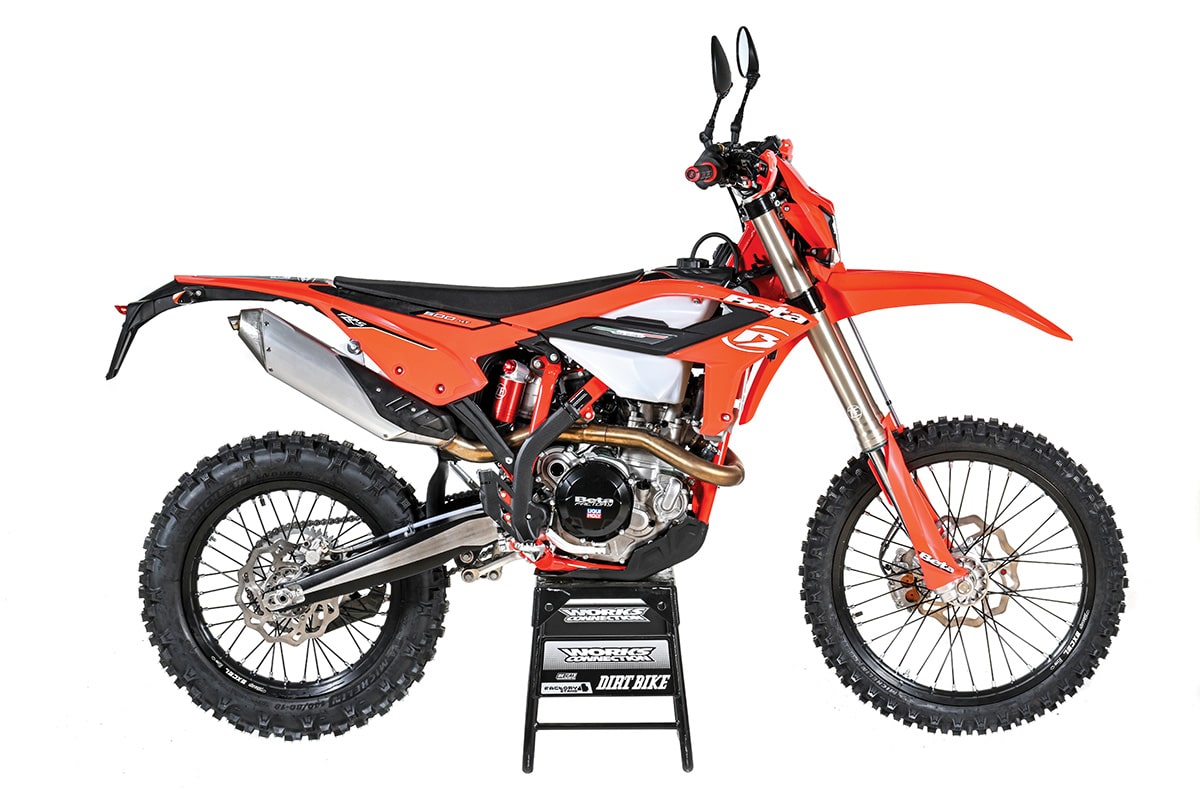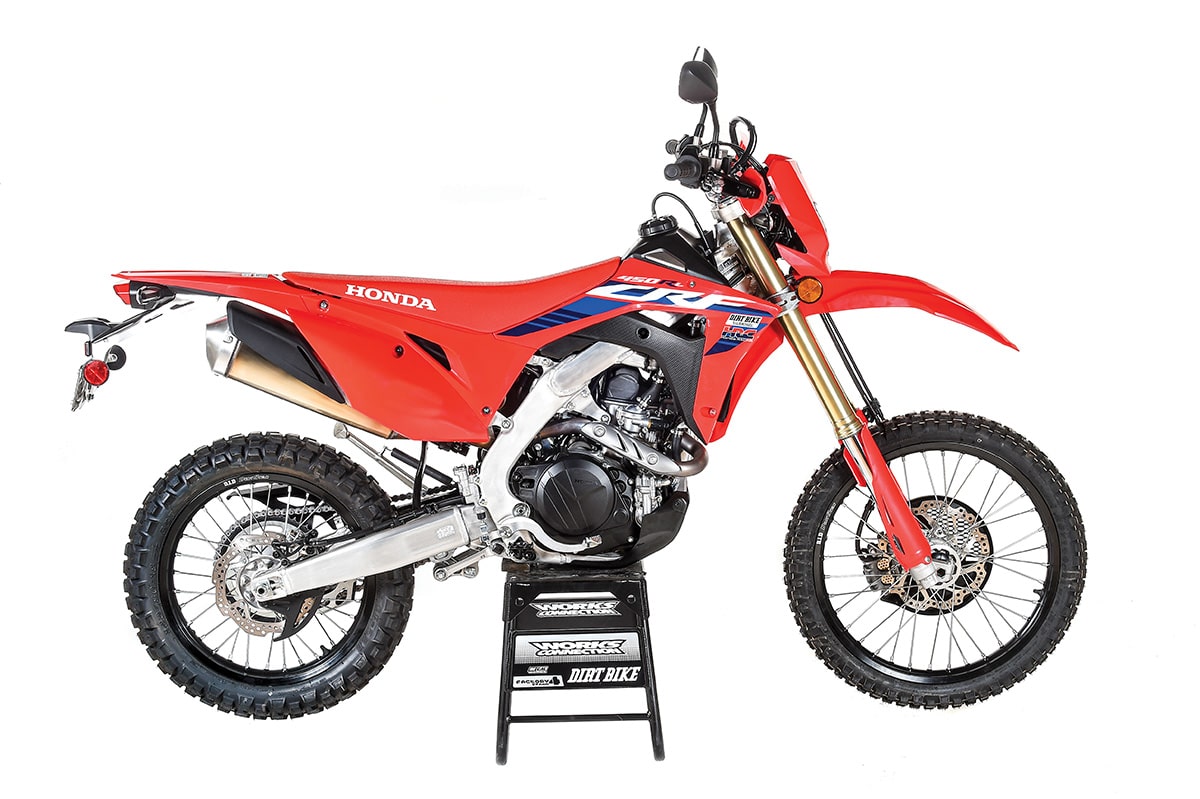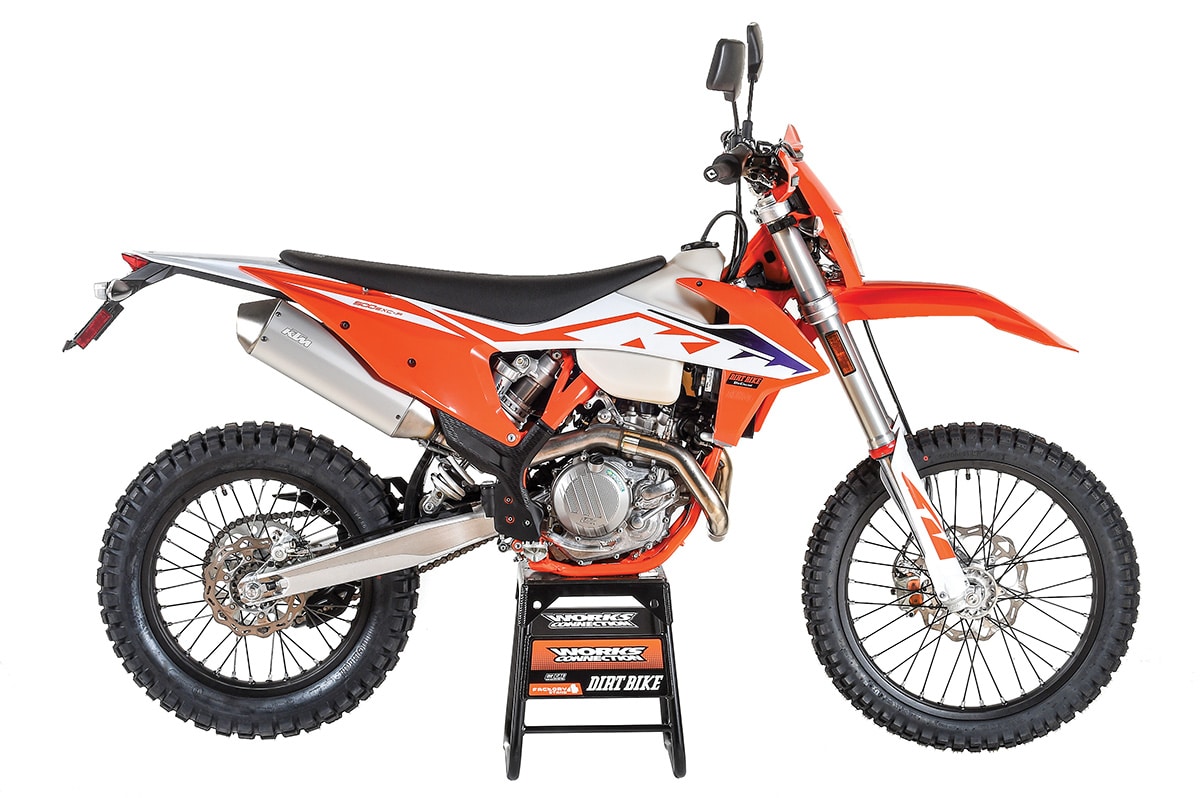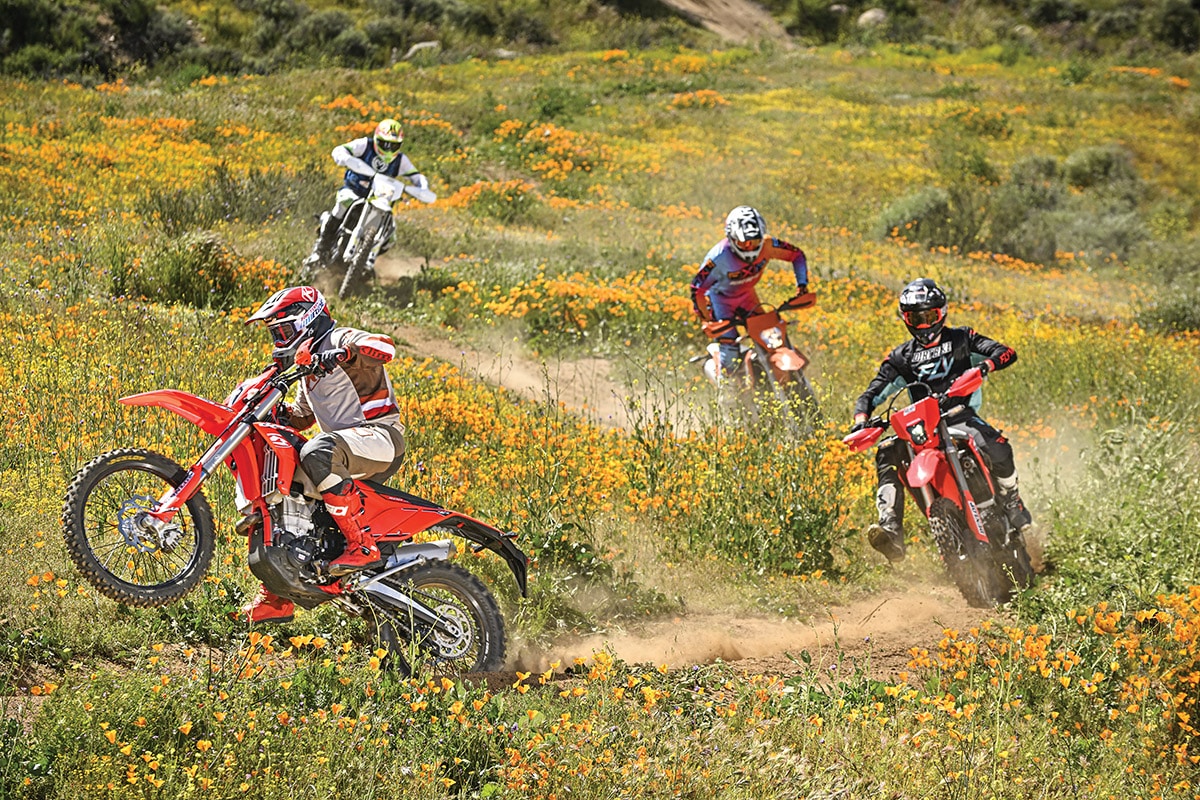We always want more. It’s our nature as riders, racers and dirt bike dudes. In the world of serious dual-sport bikes, the big stars have always been the 500s. The 300s are popular for the masses and the 350s are for purists, but it’s the 500s that get us up early and make us ride. The Beta 500RR-S, Honda CRF450RL, Husqvarna FE501S and KTM 500EXC are the elite bikes with the most performance, the least weight and the highest prices.
For our 2023 500 Dual-Sport Shootout, we selected those four bikes as the best of the best. We rode them in stock condition with the exception of tires. All of them were re-shod with Dunlop Geomax Enduro EN91 tires, which are street-legal full knobbies. We were gifted with the best riding conditions that Southern California has to offer, right at the climax of an unparalleled superbloom. And to think, some people work for a living.
BETA 500RR-S

Beta is the bad boy of the dual-sport world. The small Italian company doesn’t mind pushing the edges of legality. It’s still perfectly legal in all 50 states. It has all the mandatory street-legal equipment, it meets the right sound requirements and passes the proper emissions tests. In all those cases, the bike is right on the permissible limit, whereas Honda and the Austrians aren’t quite so brave. The Beta has the only double-overhead-cam design in the group and is the only one that offers mapping options. In front of the gas filler, there’s a little button that displays a rain cloud or a little sun emoji for the aggressive or mild map. There’s also traction control for a total of four different mapping combinations.
In the suspension department, there’s a Sachs open-cartridge fork up front, which has revised internals for 2023, and a Sachs shock with linkage in the rear. The brakes are by Nissin and the stock tires, which aren’t bad, by the way, are Michelin. The main reason we replaced them was to put all the bikes on rubber with equal wear, but we gave the first bonus points of the shootout to Beta for equipping the bike with real off-road-capable tires. This year there are very few changes to the 500RR-S, but they do include narrower radiator shrouds and new graphics. On our scale, the Beta is 254 pounds without fuel. It sells for $11,799.
HONDA CRF450RL

Honda has a history of doing something big in the dual-sport world, then turning away for years. When the Honda CRF450L came out in 2019, the world stopped spinning for an instant. Now, the bike has become a staple in Honda’s line. The only change since then was the change of the suffix to “RL” as a declaration that the bike is based on an “R” racing model and to distance it from the more pedestrian CRF300L. The bike shares much of the same architecture with the CRF450R motocross bike of that period, even though virtually all the parts are slightly different. It still uses a single-overhead-cam motor with Honda’s offset cam “Unicam” design. In this case, it has a 6-speed gearbox, and the motor is in a much milder state of tune. It has the only aluminum frame of the group and the suspension uses fairly sophisticated Showa units. The tires that came stock were IRC Trails GP, which are very street-oriented. When we replaced them with full knobbies, we also had to install rim locks. All of the other components involved are basically the same as those of the CRF450X offroad bike. It’s interesting to note the bike gained weight at every step of the way. This bike weighs more than the X, which weighs more than the R. On our scale, the CRF450RL is 277 pounds without fuel, which is considerably more than any of the others. The price, on the other hand, is considerably less at $9999. That’s actually a price reduction compared to 2019.
HUSQVARNA FE501S

Husqvarna, as everyone probably knows by now, is owned by the same parent company as KTM. That leads people to assume that the bikes are essentially the same. In some cases, that’s true, but not here. The FE501S has linkage suspension in the rear, just like Husqvarna’s motocross bikes. The KTM doesn’t, and that means there are significant differences in the frame. There are also differences in the bodywork and components. The Husqvarna has Braktec brakes and a Braktec hydraulic clutch. It has a ProTaper handlebar, D.I.D. rims and a skid plate as standard equipment. The Husky also has CNC-machined triple clamps.
Still, the list of features that are shared between the Husky and KTM is much longer. They have identical WP XPLOR forks and identical motors. This is pretty much the same motor that KTM and Husky use in all their competition four-strokes, although it’s in a milder state of tune and has a 6-speed gearbox. In order to call it a 501, the stroke is 8.4mm longer, bringing the actual displacement to 511cc. Husqvarna is very serious about keeping this bike quiet. There’s a reed valve in the air boot to quell intake noise. Even the tires were chosen with sound output in mind. The Continental TKC 80s are very street-oriented and make very little road noise. When we replaced them, we had to install the rim locks that come in the bike’s tool bag. On our scale, the 2023 Husky FE501S is 248 pounds without fuel, and it is the most expensive in this group at $12,649.
KTM 500EXC

This bike got a fairly comprehensive redesign back in 2020. That was when it got a new head and a redesigned steel frame, but the overall design concepts have been in play since 2012 when fuel injection was introduced. Today, the KTM’s most distinctive feature is its PDS no-linkage rear suspension. This isn’t your father’s PDS. It has evolved over the years, and even its harshest critics have to concede that it’s come a long way. In front, it has a coil-spring WP XPLOR fork, just like the Husqvarna. The motor is just like the Husqvarna’s as well, although it breathes a little more freely. The airbox is different, and the intake is shaped differently because the PDS shock is offset and allows more room. Like the Husky, the KTM has a reed valve in the air intake. Unlike the Husky, the KTM has Brembo brakes, Brembo clutch hydraulics, a cast-aluminum triple clamp and no skid plate. The only changes for 2023 are graphics and the color of the frame, which is orange. If this is in keeping with KTM tradition, the frame color means that next year will be a big redesign. The 500EXC is the lightest of the group at 244 pounds without fuel. It sells for $12,549.
MOTOR SWEEPSTAKES

All of these bikes have smooth, sweet power. They aren’t crazy fast, but they are fast enough. Unlike the 350cc versions of these bikes, which we tested in the April 2023 issue, you don’t find yourself thinking about modification from the word go. To put a number on it, all four bikes make somewhere in the vicinity of 40 horsepower. That’s far short of most 450 race bikes, which are in the upper 50s. But, you don’t want that kind of power in a trail bike. It’s too much work. These bikes are all easy to manage, fun to ride and definitely don’t leave you wanting.
Of the four, Beta wins the power sweepstakes. It has some real bark in the midrange. In a four-bike roll-on drag race, they would come off the line about the same, but from the middle up, the Beta would pull away and never look back. That’s a natural consequence of being in a more aggressive state of tune. The Beta has a louder exhaust, and we’re betting it has more fuel being delivered. Next bike to the drag-race finish would be the KTM, although it would be several bike lengths back and only a hair in front of the other two. As far as gear ratios go, the four bikes are freakishly similar, gear for gear. They all redline at about 34 mph in first and then have similar gaps all the way to sixth. On top, we confess we never did a Bonneville speed run, but we did do the math. All have gearing to theoretically reach 100 mph at 9000 rpm. That simply tells you that they aren’t screaming at normal highway speed.
Even though the Beta has a distinct power advantage, it’s the KTM that has the best overall character. It runs clean, never stalls and has excellent roll-on. A few years ago we would have never believed this possible from a bike with EPA-approved fuel mapping. The Beta and the Honda are more prone to stalling and have jerkier throttle response. The Honda, in particular, has an on-or-off nature down low. That makes you use the clutch a little more as a safeguard against stalling. And, if you over-use the clutch, it can fade; it’s the only bike of the four with a cable-actuated clutch.
TRAIL MANNERS

The KTM and Husqvarna have a big advantage in the weight department. They feel like real dirt bikes, and that means they can be very aggressive on the trail. The Beta is a little bigger, taller and heavier, but by no means clumsy. The fact that it’s the most powerful is the biggest reason it’s harder to manhandle. All four are absolute featherweights compared to the Honda. It’s a big boy. This ends up being a limiting factor no matter where you ride or what you do. On uphills, gravity has a big say in how far you go. On downhills, it limits how fast you can and how quickly you can stop. We can say, however, that the Honda has the best suspension of the group and maybe, just maybe, the extra weight can take a little credit. We aren’t saying that if you add 30 pounds to your bike it will suddenly have excellent suspension, but we know that when you get up to speed in whoops and rough terrain, the Honda is amazing. It goes straight and is perfectly stable. Still, the thought of getting sideways in whoops on a 277-pound motorcycle is just scary enough to make us back it down a little early.
The Beta’s suspension is softer and can get a little loose in whoops. It’s clearly designed for lower speeds and more technical riding conditions. It does very well in rock gardens and is very level and stable despite having such soft settings. You still can’t call the Beta plush, though. It has a stiff chassis and seat, which combine to transmit an uncomfortable amount of feedback to the rider. Both the KTM and the Husky deliver a much cushier, more comfortable ride. They have fork and shock settings similar to those of the Beta, but between the chassis and the seat, the end result is less harsh and more friendly.
Comparing the KTM and Husky boils down to that time-honored debate between linkage suspension and PDS. Riders can argue the virtues of both late into the night around the campfire. We generally go to bed early. To repeat what we have often said, we prefer the KTM’s PDS suspension at lower speeds. We like the action and love the extra ground clearance. At higher speeds, we feel the Husky is more level and predictable. We also like the front end of the Husky better at any speed. We give some credit to the ProTaper handlebar and the machined triple clamp.
DUEL OF THE DUALS
When you spend hours on a bike, as we tend to do with dual-sport machines, little things can become big things. Here are some random notes from the trail:
• The brakes on three of the four bikes are excellent. The Honda and the Beta use Nissin, and the KTM uses Brembo; all have good feel and excellent power. The Braktec components on the Husky are weaker and mushier.
• All four bikes have radiator fans and need them. They run hot in tight terrain. That’s a natural consequence of having lean fuel mixtures and restrictive exhausts.
• We give Beta credit for having multiple maps and traction control, but have to admit that we liked the Sunshine map without traction control in virtually all conditions. We still like having options even if we don’t use them.
• We had several electrical issues with the Beta that delayed the shootout. They related to the wiring harness and an airbox sensor, and they were handled by a dealer under warranty, just as they would for any customer.
• With large electrical switches mounted on the KTM and Husky handlebar, space is very limited, so much so that we couldn’t adjust the levers properly.
• The Husky, KTM and Beta have very floppy license-plate brackets and will eventually get sucked into the rear wheel and spit out. The Honda’s, on the other hand, is so overbuilt that you can stand on it.
• The Beta has a kickstand that’s crazy short. It generally leans at a 30-degree angle.
• KTM and Husqvarna have done an excellent job of hiding all the emissions equipment. We have no idea where they put the charcoal canister. Everything is right out in the open on the Honda.
• The Honda has the best headlight by far.
• The Beta comes with a Trail Tech GPS—standard equipment!
THE CHOICE
Picking the right dual-sport bike is actually much more difficult than choosing a motocross bike or anything else. You can’t decide with a stopwatch. Dual-sport riders are a very disparate group—some use them for commuting, others for outright competition. Here’s how we stack these four:
FIRST PLACE: KTM 500EXC

We love this bike even though it drives us a little crazy. It has a smooth power delivery, it’s incredibly light, and it has excellent trail manners. Yes, we wish it had the sheer power of the Beta and the street manners of the Honda, but we can work with what KTM has provided.
SECOND PLACE: HUSQVARNA FE501S

Obviously, the Husqvarna has many of the same virtues as the KTM. The only reason the Husky surrenders the top spot is because of its relatively small disadvantages in brakes and power. For those who plan on competition, the Husky might be the best starting point.
THIRD PLACE: BETA 500RR-S

Going in, we assumed the Beta would take the top position in this shootout, just as it did in our 350 dual-sport comparison. Horsepower is a convincing argument. As it turns out, all the 500s make enough power to please virtually anyone, and the Beta is still a little rough in the comfort department.
FOURTH PLACE: HONDA CRF450RL

An amazing number of dual-sport bikes never go off-road. So, someone else might look at the Honda as an easy winner. It’s extremely comfortable, it’s overbuilt and it has spectacular suspension. But, we are who we are. As a pure off-road machine, the CRF450RL is too much motorcycle. We’ll save it for the long rides with a loose schedule.







Comments are closed.